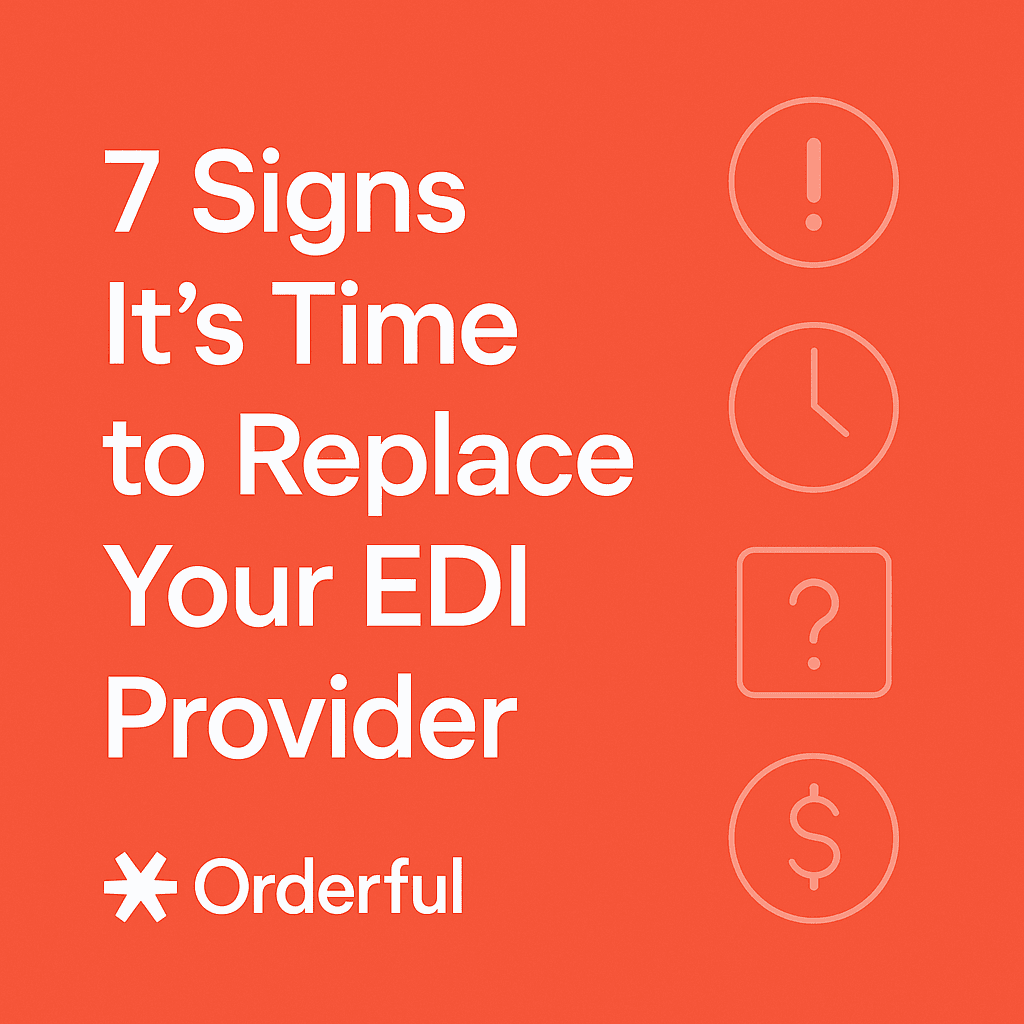If you think your current EDI provider is holding you back, check out these 7 signs it might be time to switch to a modern, scalable EDI solution.
Electronic Data Interchange (EDI) is a vital part of modern supply chains, but not every EDI provider is equipped to meet today’s shifting business demands. Outdated technology, limited integration capabilities, and poor visibility can quietly drain resources and hinder business growth. As your organization scales, a legacy EDI setup can introduce hidden costs, slow down operations, and increase compliance risks.
This guide is designed to help you evaluate whether your current EDI software provider still meets your needs. If any of the following signs feel familiar, it may be time to explore a modern EDI solution that delivers the performance, transparency, and scalability today’s businesses require.
Signs That Your EDI Provider Is Holding You Back
Modern EDI systems do much more than just exchange documents. They provide tools and reporting dashboards that help improve operational efficiency, reduce manual intervention, and scale with your business. But if your existing systems are falling short, the symptoms often show up in ways that quietly erode productivity and profit.
The seven warning signs below will help you determine whether it's time to implement a more modern solution with a new EDI provider that better aligns with your business needs.
1. Frequent EDI Downtime or Delays
Sign: Orders, invoices, or advance ship notices (ASNs) aren’t reaching your trading partners reliably or on time.
The fallout from failed or delayed EDI transactions goes beyond technical hiccups. It directly impacts your business operations. Missed ASNs can lead to chargebacks, lost shelf space, and strained relationships with retailers. For high-volume suppliers, even a small delay can trigger ripple effects across the entire supply chain.
Modern EDI software should include uptime service-level agreements (SLAs), real-time monitoring, and automated alerts to help you catch issues before they get out of hand. If your current EDI provider can’t guarantee consistent performance or routinely leaves you scrambling for answers, a new, more reliable solution is just what you need to improve EDI data accuracy and supply chain efficiency.
2. Slow or Costly Partner Onboarding
Sign: Adding a new trading partner takes weeks or requires custom coding every time.
Inefficient EDI onboarding can dramatically slow business growth. When every new partner setup involves complex data mapping, manual processes, or back-and-forth emails, your team wastes valuable time and risks costly delays. These inefficiencies can create friction with key partners and limit your ability to respond quickly to new opportunities.
A modern EDI provider should streamline the EDI onboarding process with self-service tools, standardized templates, and no-code or low-code configuration options. If your existing systems can't support fast, repeatable partner connections, it's a clear sign that you've outgrown your current EDI solution.
3. Poor Customer Support
Sign: Support tickets go unanswered, or you’re often dealing with outsourced support representatives who lack product context.
When your EDI platform breaks down, time is critical. Long response times or inconsistent support can leave your operations in limbo. Some providers also outsource support without equipping those teams to resolve technical issues efficiently, forcing your team to chase down answers across departments or time zones.
Leading EDI providers offer 24/7 support, proactive monitoring, and access to dedicated account managers who know your environment and business requirements. An EDI provider that treats support as an afterthought poses a risk to uptime and the satisfaction of your customers.
4. Limited Visibility Into Transactions
Sign: You have no easy way to check transaction status, pinpoint errors, or track the flow of business documents across partners.
A lack of transparency makes it harder to troubleshoot issues, maintain service levels, or respond quickly to partner questions. If your team is forced to dig through email threads, spreadsheets, or outdated dashboards to find answers, you risk losing time, missing deadlines, and experiencing gaps in compliance.
If you decide on a new EDI solution, it should offer user-friendly dashboards, instant alerts, and actionable reporting to help you monitor EDI operations at a glance. Real-time visibility leads to faster resolutions, fewer errors, and a stronger relationship with your trading partners.
5. Rigid Integrations
Sign: You can’t connect to ERPs, WMS platforms, or marketplaces without custom development work.
Inflexible integration requirements and EDI migration complexity are clear signs of outdated technology. If your EDI system can’t plug into your enterprise resource planning (ERP) system or other business applications without complex coding or middleware, you're likely wasting time, money, and IT resources. These integration gaps create silos, increase the risk of data errors, and make it harder to scale.
Whether they're web-based or on-premise EDI solutions, modern platforms should support API connectivity, flexible data mapping, and ERP integrations to help your newly integrated EDI services connect seamlessly with your existing systems. If your provider lacks these capabilities, switching to a more modern EDI solution can unlock long-term agility and cost savings.
6. Hidden or Rising Costs
Sign: You’re getting billed for every new partner, EDI process, document type, or data map, and the costs keep creeping up.
Many EDI services operate on pricing models that penalize growth. Whether it’s hidden fees for onboarding, extra charges per transaction, or expensive customizations, these costs can add up fast. Over time, they create a gap between what you're paying for and the value that you actually receive.
An EDI provider should offer transparent pricing, flexible plans, and predictable cost structures that align with your business requirements. If your current EDI provider makes it hard to estimate costs, or if they introduce unexpected charges, it may be time to explore a solution that puts cost control and scalability first.
7. Your Business Has Outgrown Their Capabilities
Sign: Your current EDI provider struggles to support your expanding product catalog, trading partner network, or geographic reach.
As your business grows, your EDI solution should grow with you. But legacy systems often hit a wall when it comes to volume, complexity, or global coordination. If delays, manual workarounds, or platform outages become more frequent as your capabilities expand, you may be pushing your provider beyond its limits.
The right EDI provider should offer enterprise-grade performance, support for high transaction volumes, and a broad trading partner network. If your current system relies on old technology and outdated security protocols, or it can’t handle your operational growth, it’s time to consider a new EDI system built to scale as your business grows.
What to Look For in a Modern EDI Provider
If your current EDI setup is slowing you down, the next solution you choose should be built for where your business is headed, not where it’s been. Modern EDI providers are evolving quickly, with features designed to meet real-time demands, reduce overhead, and scale with your operations.
Here’s what to prioritize when comparing options:
Migration support: Seek out software providers who can provide confident and knowledgeable support throughout your EDI migration process.
Cloud-native architecture: Look for providers that offer flexible, cloud-based EDI and web EDI vs. on-premise solutions. This makes scaling easier, improves accessibility, and reduces IT burden.
Real-time visibility and alerts: Proactive monitoring, real-time status updates, and error notifications help your team respond faster and avoid costly delays.
Self-service onboarding and automation: Platforms with no-code configuration tools and intuitive setup flows simplify the onboarding process, especially helpful when working with multiple trading partners.
ERP and API integrations: Seamless connections with platforms like NetSuite and other enterprise resource planning (ERP) systems can streamline workflows and minimize manual intervention.
Transparent pricing: Your next provider should offer clear, predictable pricing models that reflect your actual usage, not hidden fees.
Scalability and support: A wide trading partner network, enterprise-grade performance, and responsive customer service will ensure your EDI system evolves as your business does.
Legacy vs Modern EDI Providers
Feature/Challenge | Legacy EDI Provider | Modern EDI Provider |
|---|---|---|
Downtime | Frequent outages, no alerting | ✅ SLA-backed uptime, real-time alerts |
Partner Onboarding | Manual setup, long timelines | ✅ Self-service, fast onboarding |
Support | Outsourced, slow responses | ✅ 24/7 support with EDI specialists |
Visibility | Limited dashboard or reporting | ✅ Real-time tracking, error alerts |
Integrations | Custom coding required | ✅ API, ERP, WMS connectors built-in |
Pricing | Hidden fees, per-transaction charges | ✅ Transparent, flat-rate or usage-based |
Scalability | Breaks under growth or complexity | ✅ Built for scale with large partner networks |
Smarter EDI Starts Here
Whether you're dealing with outdated technology, limited visibility, or rising costs, the signs of EDI failure often point to a single root cause: your provider isn’t keeping up. Replacing your EDI provider may sound like a big move, but the cost of staying with a system that holds you back can be even greater.
If you’re ready for faster onboarding, better support, and a platform built for real-time supply chain management, it may be time to switch to a provider that understands what modern businesses really need.
Talk to an EDI expert today to see how Orderful can help you automate processes, reduce errors, and integrate seamlessly with your existing systems.
Frequently Asked Questions
What are signs of a failing EDI system?
Signs of EDI failure include frequent downtime and delayed transactions. These issues can impact operational efficiency, increase compliance risks, and hurt your supply chain performance.
Is cloud-based better than an on-premise EDI solution?
The better solution depends on business goals. Cloud-based EDI offers greater flexibility, faster scaling, and easier integrations compared to on-premise solutions. On-premise platforms offer broader security options and stricter controls but require a dedicated IT staff.
What are the risks of staying with a legacy EDI provider?
Legacy EDI platforms often introduce hidden costs, delayed transactions, and poor integration with ERP systems. These risks can reduce operational efficiency and limit your ability to scale.
How do I evaluate an EDI provider?
Look at platform reliability, onboarding speed, integration options, pricing transparency, and customer support. Your provider should align with both your technical and business growth needs.
Can I switch EDI providers without re-onboarding everyone?
Yes. Platforms like Orderful decouple EDI logic from trading partners using an API-first model, allowing you to migrate without rebuilding each connection.
How much does switching EDI providers cost?
Costs vary based on partner count, document types, and integration needs. However, modern providers often offer flat pricing and faster ROI by reducing delays, errors, and support overhead.
What’s the biggest sign it’s time to replace my EDI system?
If your provider can’t support real-time operations, has poor visibility, or makes scaling expensive and slow - you’ve likely outgrown them.

